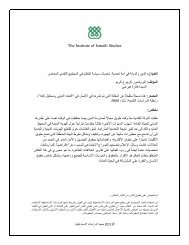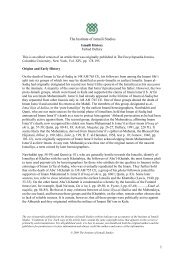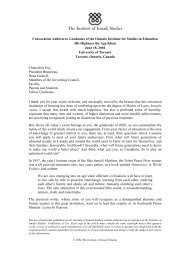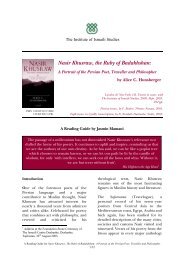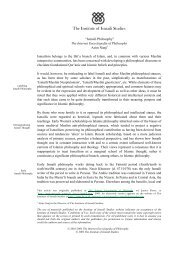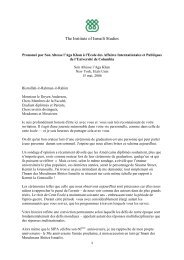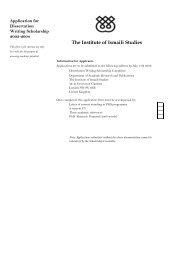BM-IIS Conference Pack.qxp - The Institute of Ismaili Studies
BM-IIS Conference Pack.qxp - The Institute of Ismaili Studies
BM-IIS Conference Pack.qxp - The Institute of Ismaili Studies
You also want an ePaper? Increase the reach of your titles
YUMPU automatically turns print PDFs into web optimized ePapers that Google loves.
<strong>BM</strong>-<strong>IIS</strong> <strong>Conference</strong> <strong>Pack</strong>.<strong>qxp</strong> 20/03/2009 14:13 Page 18<br />
claimed over their Abbasid rivals. Shorter tags (such as ‘Ali wali Allah) occur on the<br />
coins <strong>of</strong> the Fatimids’ Iranian contemporaries (e.g. the Bavandids), establishing a<br />
tradition that continued intermittently in northern Iran. It was only with the Ilkhanid<br />
ruler Uljaytu that extended Shi‘i numismatic legends appear (including the names <strong>of</strong><br />
the Twelve Imams). <strong>The</strong>reafter Shi‘i phrases occur occasionally until the Safavid period,<br />
again mostly in the mints <strong>of</strong> northern and eastern Iran. In some cases, a ruler might<br />
choose to place a pro-Shi‘i inscription on the coinage <strong>of</strong> a particular mint, only to be<br />
prevented from doing so by the local scholars (e.g. the Timurid Husayn Bayqara who<br />
wanted to place the names <strong>of</strong> the Twelve Imams on the coinage <strong>of</strong> Harat in AH 873, but,<br />
according to Khwandamir’s Habib al-Siyar, was prevented from doing so by the Hanafis<br />
<strong>of</strong> that city). With the advent <strong>of</strong> the Safavids, the Shi‘i kalima and the names <strong>of</strong> the<br />
Twelve Imams became standard features <strong>of</strong> the coinage and later Safavid rulers<br />
introduced self-abasing devotional epithets into their numismatic titulature (e.g. kalb-e<br />
astan-e ‘Ali). Some evidence for Shi‘i legends is also to be found in Indian Islamic<br />
coinage <strong>of</strong> the same period. In Iran, the tradition continued until the reign <strong>of</strong> Fath ‘Ali<br />
Shah <strong>of</strong> the Qajar dynasty.<br />
Dr Luke Treadwell is University Lecturer in Islamic Numismatics and Curator <strong>of</strong> Islamic<br />
Coins, Ashmolean Museum. His research interests include the history <strong>of</strong> the Islamic<br />
Mashriq before the Seljuks, ‘Abd al-Malik’s coinage reforms, and coinage <strong>of</strong> the Islamic<br />
world before the Mongols. He also lectures in the Master’s programmes in Islamic<br />
material culture at the Khalili Research Centre for the Art and Material Culture <strong>of</strong> the<br />
Middle East at Oxford. Dr Treadwell’s publications include: Buyid Coinage: a Die Corpus<br />
(322-445 A.H.) (Oxford 2001); “A New Text on <strong>Ismaili</strong>sm at the Samanid Court” in C.<br />
F. Robinson (ed.), Texts, Documents and Artefacts: Islamic <strong>Studies</strong> in Honour <strong>of</strong> D. S. Richards<br />
(with P. Crone, Leiden 2003); “<strong>The</strong> account <strong>of</strong> the Samanid dynasty in Ibn Zafir al-<br />
Azdi’s Akhbar al-duwal al-munqati’a”, Iran 43 (2005): 135-171; “‘Mihrab and Anaza’ or<br />
‘Sacrum and Spear’ – A Reconsideration <strong>of</strong> the Iconography <strong>of</strong> an Early Marwanid<br />
Silver Drachm”, Muqarnas 22 (2005): 1-28; and “<strong>The</strong> Copper Coinage <strong>of</strong> Umayyad<br />
Iran”, Numismatic Chronicle (2009, forthcoming).<br />
OYA PANCAROGLU<br />
Chair for the panel, “Iconography Beyond Shi‘i Contexts”<br />
Oya Pancaroglu is currently Associate Pr<strong>of</strong>essor in the Department <strong>of</strong> History, Bogaziçi<br />
University, Istanbul. She received her PhD in Islamic Art in 2000 from Harvard<br />
University with a thesis on transformations in figural representation in the medieval<br />
eastern Islamic world. Between 2000 and 2006, she held appointments at the University<br />
<strong>of</strong> Oxford as Post-Doctoral Research Fellow and as Departmental Lecturer. Her<br />
research interests include the literary extensions <strong>of</strong> the visual arts in the greater Iranian<br />
world <strong>of</strong> the early and medieval Islamic periods and the architectural reflections <strong>of</strong> the<br />
social and religious contexts <strong>of</strong> medieval Anatolia between the 12th and 15th centuries.<br />
She teaches survey and thematic courses on medieval Islamic art as well as courses on<br />
early Islamic and Turkic history. Since 2008, she is serving as an advisor for the<br />
medieval Islamic (Abbasid) period finds <strong>of</strong> the Tarsus excavation project (Gözlükule<br />
mound) led by Bogaziçi University. Her publications include: Perpetual Glory: Medieval<br />
Islamic Ceramics from the Harvey B. Plotnick Collection [exh. cat.] (New Haven and London<br />
2007); “Caves, Borderlands and Configurations <strong>of</strong> Sacred Topography in Medieval<br />
Anatolia”, Mésogeios 25-26 (2005): 249-81; “<strong>The</strong> Itinerant Dragon Slayer: Forging Paths<br />
<strong>of</strong> Image and Identity in Medieval Anatolia”, Gesta 43/2 (2004): 151-64; and “Signs in<br />
the Horizons: Concepts <strong>of</strong> Image and Boundary in a Medieval Persian Cosmography”,<br />
Res: Anthropology and Aesthetics 43 (2003): 31-41.<br />
ZEYNEP YUREKLI-GORKAY<br />
Paper Abstracts and Academic Biographies<br />
“Icon, Emblem, Amulet, Identity Marker: the Sword <strong>of</strong> ‘Ali and the Ottoman Ghazis”<br />
According to common belief and several accounts, the Prophet Muhammad gave the<br />
legendary sword Dhu’l-fiqar to ‘Ali b. Abi Talib during the battle <strong>of</strong> Uhud, and later on,<br />
Imam Husayn used it at the battle <strong>of</strong> Karbala. Represented usually either with a slightly<br />
tilted and two-pointed blade or two diverging blades, it became an attribute <strong>of</strong> Imam



